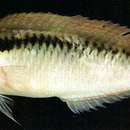Diagnostic Description
provided by Fishbase
The initial phase is olivaceous to brownish yellow dorsally, white ventrally, with a black zigzag stripe running from eye to upper caudal peduncle (continuing anteriorly as a yellow stripe from the eye to the snout). This primary phase is similar to H. trimaculatus except for the black zigzag stripe along its back (Ref. 1602). The terminal phase is green, the zigzag stripe lavender-pink with its anterior portion overlaid by a black blotch.
Life Cycle
provided by Fishbase
Distinct pairing during breeding (Ref. 205). Pelagic spawner (Ref. 32193).
Morphology
provided by Fishbase
Dorsal spines (total): 9; Dorsal soft rays (total): 11; Analspines: 3; Analsoft rays: 11
Trophic Strategy
provided by Fishbase
Occurs inshore (Ref. 75154). Common in shallow lagoons or bays; usually over sand, rubble, or seagrass bottom, rather than on coral reefs. Usually solitary and aggressive towards members of its own species. Feeds on small crustaceans by picking them off the sandy bottom (Ref. 5503).
- Recorder
- Drina Sta. Iglesia
Biology
provided by Fishbase
Common in shallow lagoons or bays; usually over sand, rubble, or seagrass bottom (Ref. 41878), rather than on coral reefs. May be found in groups (Ref. 90102). Usually solitary and aggressive towards members of its own species. Feeds on small crustaceans by picking them off the sandy bottom (Ref. 5503).
- Recorder
- Estelita Emily Capuli
Importance
provided by Fishbase
fisheries: minor commercial; aquarium: commercial; price category: very high; price reliability: very questionable: based on ex-vessel price for species in this family
- Recorder
- Estelita Emily Capuli
分布
provided by The Fish Database of Taiwan
分布於印度-西太平洋區,由紅海、東非到巴布新幾內亞,北至琉球群島,南至澳洲大堡礁海域等。台灣除西部外,各地海域皆有分布。
利用
provided by The Fish Database of Taiwan
中小型之隆頭魚,體色鮮豔,是適合水族觀賞的魚類,亦可食用。臺灣四周岩岸海域都可發現牠的蹤影,為常見珊瑚礁中的魚種。
描述
provided by The Fish Database of Taiwan
體延長,側扁。吻較長,尖突。前鼻孔具短管。口小;上頜有犬齒四枚,外側兩枚向後方彎曲。前鰓蓋後緣具鋸齒;鰓蓋膜常與峽部相連。體被中大圓鱗,胸部鱗片小於體側,鰓蓋上方有一小簇鱗片;眼下方或後方無鱗。D.
IX, 11;A. III, 11;P. 14;L.l. 26;G.R.
17-21。體色隨性別與個體而異,幼雌魚體背側由橄欖黄至黄褐色,腹側白色,體側有一條黑色連續似"Z"字形縱帶,此縱帶在頭後部另有黄色縱紋參雜,尤其是下側最為明顯,而且向前延伸至吻部,形成另一條黄色縱紋,尾柄上側無暗色斑;雄魚淡綠色,縱帶漸退或消失,而在胸鰭基上方形成一黑斑,體側鱗片出現粉紅色垂直緣,頭部亦具粉紅色之斑塊或線紋,從胸鰭至腹部另具一斜紅紋,背、臀及尾鰭各具多條粉紅色之縱紋或垂直紋。
棲地
provided by The Fish Database of Taiwan
主要棲息於礁區外緣的海草平台、砂石地,以及淺水礁湖及海灣。經常自由自在的獨自巡游或群居,用尖尖的吻部由砂石底部翻出好吃的小甲殼類為食。具性轉變的行為,是屬於先雌後雄型的型態。
Halichoeres scapularis
provided by wikipedia EN
Halichoeres scapularis, commonly called the Zigzag wrasse , is a fish species in the wrasse family native from the Indo-West Pacific.[3]
Description
The zigzag wrasse is a small fish that can reach a maximum length of 20 cm.[3]
It has a thin, elongate body with a terminal mouth. Its coloration pattern varies depending on the maturity stages.
As a juvenile and a female, the zigzag wrasse has a pearly white background coloration with a black or yellow or also black and yellow stripe zigzagging along the lateral line.
As a mature male, the body coloration is very elaborated. The inferior side of the lateral line is pearly with pinkish reflection. The black or yellow line tend to disappear with age or it can be reduced to a short dash. The superior part is greenish with pink accents until the base of the dorsal fin. The base of the dorsal fin is highlighted by a bright yellow line. Then superimposed over this later yellow line a blue line, a yellow one, green one and finally a fin pinkish one. The iris of the eye is orange.
Distribution & habitat
The zigzag wrasse is widespread throughout the tropical and subtropical waters of the Indo-West Pacific, from the eastern coast of Africa, Red Sea included, to the Philippines and from New Caledonia to south Japan.[1]
The zigzag wrasse appreciates mixed areas of top reef (sand/rubble/corals) in shallow water down to 20 meters depth.[3]
Biology
The zigzag wrasse can live in small group[4] but is usually solitary and even aggressive towards members of its own species.[5]
Like most wrasse, the chain-lined wrasse is a protogynous hermaphrodite, i.e. individuals start life as females with the capability of turning male later on.
Conservation status
The species is targeted but not thought to be threatened by the aquarium trade. It is listed as Least Concern (LC) on the UICN.[1]
References
-
^ a b c Craig, M.; Rocha, L. (2010). "Halichoeres scapularis". IUCN Red List of Threatened Species. 2010: e.T187454A8539682. doi:10.2305/IUCN.UK.2010-4.RLTS.T187454A8539682.en. Retrieved 20 November 2021.
-
^ Froese, Rainer; Pauly, Daniel (eds.) (2019). "Halichoeres scapularis" in FishBase. August 2019 version.
-
^ a b c Lieske & Myers,Coral reef fishes,Princeton University Press, 2009, ISBN 9780691089959
-
^ Allen, G.R. and M.V. Erdmann, 2012. Reef fishes of the East Indies. Perth, Australia: University of Hawai'i Press, Volumes I-III. Tropical Reef Research.
-
^ Cornic, A., 1987. Poissons de l'Ile Maurice. Editions de l'Océan Indien, Stanley Rose Hill, Ile Maurice. 335 p.

- license
- cc-by-sa-3.0
- copyright
- Wikipedia authors and editors
Halichoeres scapularis: Brief Summary
provided by wikipedia EN
Halichoeres scapularis, commonly called the Zigzag wrasse , is a fish species in the wrasse family native from the Indo-West Pacific.
- license
- cc-by-sa-3.0
- copyright
- Wikipedia authors and editors
Description
provided by World Register of Marine Species
Common in shallow lagoons or bays; usually over sand, rubble, or seagrass bottom, rather than on coral reefs. Usually solitary and aggressive towards members of its own species. Feeds on small crustaceans by picking them off the sandy bottom (Ref. 5503).
Froese, R. & D. Pauly (Editors). (2023). FishBase. World Wide Web electronic publication. version (02/2023).
- license
- cc-by-4.0
- copyright
- WoRMS Editorial Board

